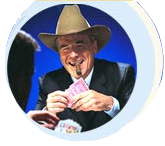Just as you read facial expressions and body language of your poker opponents, there are signals to be aware of while playing poker online. Chances are if you don’t know how to read an “online poker face” you are sending telltale signals subconsciously to your opponents.
Through your experiences in the game of poker, you have learned to watch the players look at their cards for the first time. You watch them call or raise a bid. You even pay attention when they fold their hand. Did you see that eyebrow rise? A stifled smirk? Maybe someone put their hand face down on the table, or took a long drag of their cigar. You have learned to pick up on your opponents’ mannerisms and habits through observation. He raised the bid, but you’ll call his bluff.
You need to study your opponents just as you would if they were there in person. You can learn of one’s character, confidence, and skill level just as easily over the Internet. Here are some things to look out for when reading an “online poker face,” and how to be cautious of your own dead-giveaways.
First of all, a novice is just as easy to pick out of a crowd. If an opponent uses the chat feature to wish everyone good luck before the game starts, this is a good indication that he/she is an inexperienced player. Players who chat are often unaware that they are giving away valuable information. The first thing to remember is the participants are distracted from the game. You can learn about the extent of their distraction by paying attention to what is being said. Is an opponent drunk? Tired? Watching young kids?
Also, if a player chooses to show his hand, you can bet that he is probably a beginner. Experienced players know that there is nothing to gain by sharing their cards. Another strong indicator of a beginner is if he bets an odd amount of chips. Unless the bet matches the count of the stack, the opponent is merely trying to create an illusion of a larger bet. The last related tip-off is if you learn that your opponent is multi-tabling, you can assume he is a strong player. However, if they are revealing this information by way of chatting, rest-assured they are beginners to it.
If you decide one of your opponents is a novice…well…your game just got a little easier. However, don’t let your guard down completely. A beginner has yet to form consistent tells and, therefore, might be a bit tricky to read.
A pattern to watch out for (in both skilled and unskilled players) is the time it takes your opponents to bet. A general rule of thumb is a player will act quicker with a good hand and hesitate if their cards are weaker. However, an experienced player might try to trick you. Study your opponents carefully so that you can detect a false tell. Also, don’t forget about your own “poker face.” Be the trickster. Keep your betting times to a consistent three seconds whether you have good cards or not—this means whether you are calling, raising, or folding. At certain times, act quicker with a weak hand and dawdle with a strong hand. You may even want to run down the timer until the last possible moment during a better hand. But don’t overuse this trick! This will help keep you unpredictable and difficult to read.
You may decide to take notes on your opponents. You can keep short files about each player you encounter. This will help you with your current game, and may even prove useful in the future if you run into that player again. It’s time to play online poker!
By Victoria Maro
